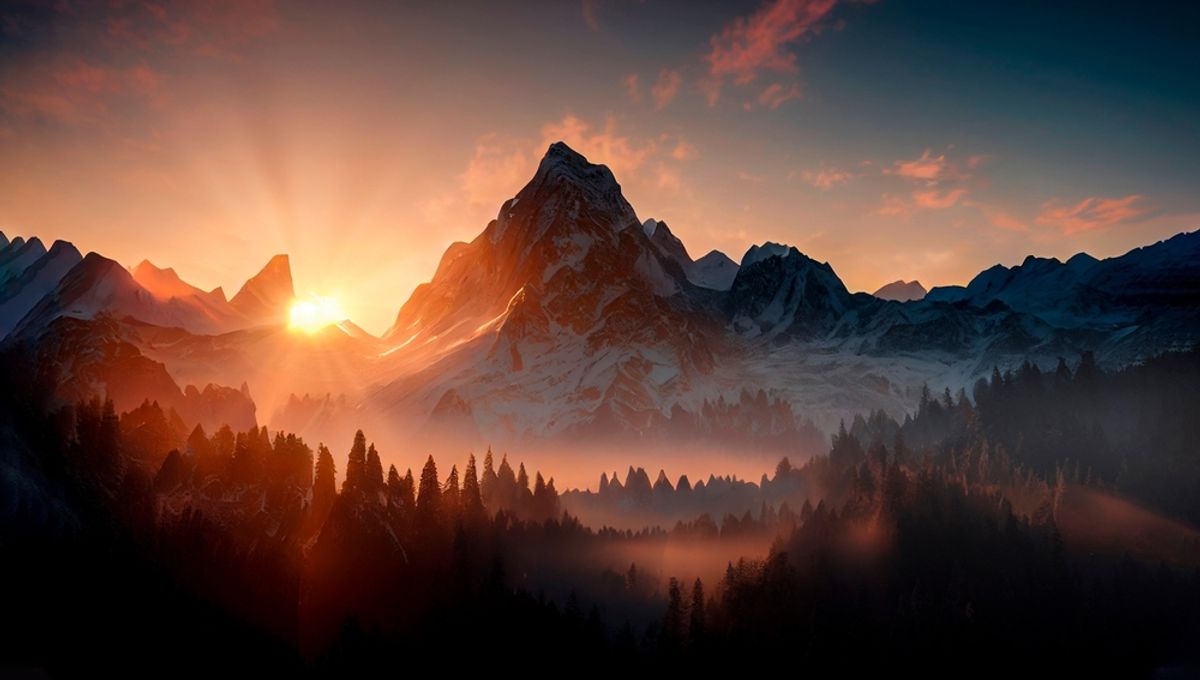
That hot air rises is one of physics’s most widely known principles. If you live in a house with more than one story you’ve felt how air conditioning can be almost essential for survival upstairs, but a luxury below. Yet the tops of mountains are the first places to get snow; that’s if they’re not ice-covered all year round. The apparent contradiction has no doubt occurred to many people, but usually when feeling the cold on a mountainside, making it an inconvenient time to seek an answer.
Fortunately, however, access to the Internet now extends even to many hillsides, so allow us to answer it.
Why Does Hot Air Rise?
A gas’s temperature is a measure of the kinetic energy of the atoms or molecules that make it up. More energy means they move faster. If the gas is in a rigid container like a storage vessel, this translates to extra pressure. However, if the container is flexible – think a balloon – the extra pressure on the material will force it outwards, causing the balloon to expand.
With the same amount of material in a larger space the balloon will the lighter, causing it to float on top of the surrounding gas.
Without a balloon the hot air will do the same thing, expanding to fill more space and floating on the cooler air below.
Unless the walls of your house are unusually flexible, the hot air won’t be able to cause them to expand. Instead, it will rise until trapped by the ceiling, creating a warmer layer in the uppermost story, with cooler air below.
Why Does It (Usually) Get Cooler With Altitude?
One might expect from this that outdoors the same thing would happen.
After all, sunlight heats the ground, warming air nearby, which rises. You can see the effect of this on windless sunny days when birds of prey or glider pilots can circle for hours expending little energy, buoyed by the rising air.
Yet it would be a bad idea indeed to take this as a sign one can soar or climb to high altitude without needing to rug up warmly.
The reason is that outdoors there is nothing to constrain the air. Not only does the hot air expand as it would in an infinitely flexible balloon, but the air pressure overall falls as one gets further from the Earth’s surface. Gravity holds the bulk of the atmosphere close to the ground, so the further one rises towards space the sparser the molecules are and the lower the pressure.
As hot air rises it encounters less and less pressure and expands accordingly. This expansion cools it down. There are a few ways to think of why this occurs.
One is that when a gas expands it does work – an observation key to the workings of engines. It takes energy to do work, and doing it means losing some of that energy. Since, as we discussed before, temperature is a measure of kinetic energy, losing energy makes a gas cooler. Another perspective is that as the particles become more spread out those that are attracted to each other gain potential energy, like an object lifted higher off the ground. Since energy is not created or destroyed, this potential energy has to come from somewhere, and in this case that is a decline in the particle’s kinetic energy, ie temperature.
But Not Always And Forever…
The temperature does not fall endlessly as one rises through the atmosphere. If it did – at least at the rate it falls at first – we’d be down to absolute zero long before we reached space. Instead, once you reach the boundary between the troposphere and tropopause – usually around 12 km (7 miles) up – temperatures stabilize and then start rising again. Since they do this at temperatures around – 60° C (-76° F) this is something best observed with instruments, not felt. Further up temperatures reverse again, twice. The reasons for these changes in direction are too complex to go into here, but have to do with factors like the changing mixture of gasses, and the wavelengths of radiation they absorb.
Sometimes we get what is known as a “temperature inversion” where it gets warmer for a while as one goes up. High altitude air can sink, and act as a lid – somewhat replicating ceiling so that warmer air is trapped beneath it, and temperatures rise as you go higher.
Such inversions can be dangerous. Most obviously they can they lull climbers into a false sense of security about the temperature, which can then fall rather suddenly if the “lid” is removed. A far more common cause of death is when they trap pollution beneath them, which can sometimes last for days.
Oh And Those Flat Earthers…
There are much better proofs that the Earth is round. Nevertheless, air cooling with altitude is indirectly one of them. As you go up through the atmosphere during daytime you’re getting closer to the Sun. The story of Icarus shows the ancient Greeks thought this meant it would get hot. That doesn’t happen, however, because the distance to the Sun is so immense that getting a few hundred meters, or even a few kilometers, closer makes no appreciable difference.
However, if you have the misfortune to be spammed by Flat Earthers, as sadly we do, many of their messages will tell you that the Sun is not the 150 million kilometers away, as measured by astronomers. Instead, they claim it is actually quite nearby (and small), an assessment necessary to deal with a few of the more obvious problems with their worldview. But if the Sun really was that close, then the higher altitudes would mean getting significantly closer, proportionally, and should result in higher temperatures. Sadly, if all the better evidence doesn’t convince them, it’s unlikely this will.
Source Link: Hot Air Rises, So Why Is It Colder On Mountaintops?